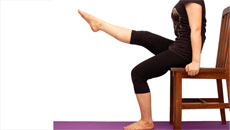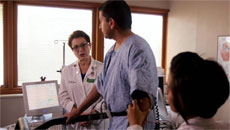Maintaining perfect posture, on a round and mobile surface can be effective in building strength, and challenging your abdominal and back muscles like nothing else. A stability ball may look simple and its benefits minimal, but really, because the ball demands balance, you will work muscles you never knew you had or challenge them in a different way.
Besides being a tremendous benefit to your body, it adds another layer of variety to your current strength training. By replacing a solid surface with the ball, you can add a completely new level of coordination and balance to your seated and lying exercises; not to mention the great core muscle strength and endurance you develop from stabilizing your body during all of your sets and repetitions. Here are a few exercises to try.
Stationary Lunge
1. Start with a large stability ball behind you. Carefully place a leg on the ball. Your shin should be in contact with the top of the ball. Place your front leg as far out in front of you back leg as you can while maintaining your balance and comfort. Your front foot should be planted firmly on the floor.
2. To perform this stability ball exercise, lower yourself by slowly bending your front leg until the top of your leg is parallel to the floor. Be sure to keep your back leg firmly on top of the stability ball throughout the movement.
3. Finish the repetition by returning to the starting position.
4. Repeat the movement, performing the required number of reps. Repeat with the opposite leg on the ball.
Stability Ball Crunch
1. Start by sitting on the exercise ball as if you were sitting on a chair. Slowly lean back and walk your feet forward until the ball is positioned on your lower back region and you are looking toward the ceiling. The top your legs should be parallel to the floor.
2. Cross your hands on your chest and keep your head in a neutral position looking forward (toward the ceiling). Your chin should not touch your chest at any point during this exercise.
3. Raise your torso by contracting your abdominals to perform the crunch.
4. Hold for a count, squeeze your abdominals, and return to starting position.
Oblique Stability Ball Crunch
1. Begin by kneeling down on one knee beside the exercise ball with the knee that is on the floor next to the fitness ball.
2. Carefully lie sideways over the stability ball. You bottom arm (arm closest to the ball) should be bent with your hand behind your head and your top arm (arm farthest from the ball) can either be in the same position (hand behind head) or lying on your side
3. Slowly raise you body upward by lifting your shoulder, pushing your hips into the ball and pulling with your obliques, making sure not to twist your body.
4. Squeeze your obliques for a count and then slowly lower yourself back to the starting position.
Wall Squat
1. Begin by placing your stability ball against a wall, and, while standing upright, lean against the ball with your back. Your feet should be slightly out in front of you and approximately shoulder width apart.
2. Using a controlled motion, lower your self until the top of your thighs are parallel to the floor.
3. Slowly return to the standing upright position by pressing your feet into the floor and pushing your body back to upright.
Abdominal Tuck
1. Start with your shins on the stability ball with your hands on the floor in a push-up position. The closer the ball is located toward your feet, the more difficult this exercise will become.
2. Pull the fitness ball toward your chest by bending your knees and lifting your hips until you are in the tucked position with your knees at your chest.
3. Carefully return the exercise ball to the starting position by extending your legs until you are again in the push up pose.






